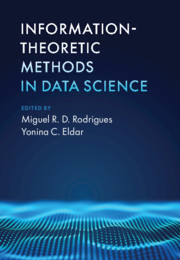Refine search
Actions for selected content:
2327 results in Pattern Recognition and Machine Learning
4 - Information-Theoretic Bounds on Sketching
-
-
- Book:
- Information-Theoretic Methods in Data Science
- Published online:
- 22 March 2021
- Print publication:
- 08 April 2021, pp 104-133
-
- Chapter
- Export citation
5 - Sample Complexity Bounds for Dictionary Learning from Vector- and Tensor-Valued Data
-
-
- Book:
- Information-Theoretic Methods in Data Science
- Published online:
- 22 March 2021
- Print publication:
- 08 April 2021, pp 134-162
-
- Chapter
- Export citation
Contributors
-
- Book:
- Information-Theoretic Methods in Data Science
- Published online:
- 22 March 2021
- Print publication:
- 08 April 2021, pp xix-xxii
-
- Chapter
- Export citation
8 - Computing Choice: Learning Distributions over Permutations
-
-
- Book:
- Information-Theoretic Methods in Data Science
- Published online:
- 22 March 2021
- Print publication:
- 08 April 2021, pp 229-262
-
- Chapter
- Export citation
Index
-
- Book:
- Mathematical Foundations of Infinite-Dimensional Statistical Models
- Published online:
- 05 March 2021
- Print publication:
- 25 March 2021, pp 687-690
-
- Chapter
- Export citation
References
-
- Book:
- Mathematical Foundations of Infinite-Dimensional Statistical Models
- Published online:
- 05 March 2021
- Print publication:
- 25 March 2021, pp 667-682
-
- Chapter
- Export citation
Contents
-
- Book:
- Mathematical Foundations of Infinite-Dimensional Statistical Models
- Published online:
- 05 March 2021
- Print publication:
- 25 March 2021, pp vii-x
-
- Chapter
- Export citation
5 - Linear Nonparametric Estimators
-
- Book:
- Mathematical Foundations of Infinite-Dimensional Statistical Models
- Published online:
- 05 March 2021
- Print publication:
- 25 March 2021, pp 389-466
-
- Chapter
- Export citation
Preface
-
- Book:
- Mathematical Foundations of Infinite-Dimensional Statistical Models
- Published online:
- 05 March 2021
- Print publication:
- 25 March 2021, pp xi-xiv
-
- Chapter
- Export citation
7 - Likelihood-Based Procedures
-
- Book:
- Mathematical Foundations of Infinite-Dimensional Statistical Models
- Published online:
- 05 March 2021
- Print publication:
- 25 March 2021, pp 541-606
-
- Chapter
- Export citation
Frontmatter
-
- Book:
- Mathematical Foundations of Infinite-Dimensional Statistical Models
- Published online:
- 05 March 2021
- Print publication:
- 25 March 2021, pp i-iv
-
- Chapter
- Export citation
8 - Adaptive Inference
-
- Book:
- Mathematical Foundations of Infinite-Dimensional Statistical Models
- Published online:
- 05 March 2021
- Print publication:
- 25 March 2021, pp 607-666
-
- Chapter
- Export citation
Dedication
-
- Book:
- Mathematical Foundations of Infinite-Dimensional Statistical Models
- Published online:
- 05 March 2021
- Print publication:
- 25 March 2021, pp v-vi
-
- Chapter
- Export citation
2 - Gaussian Processes
-
- Book:
- Mathematical Foundations of Infinite-Dimensional Statistical Models
- Published online:
- 05 March 2021
- Print publication:
- 25 March 2021, pp 15-108
-
- Chapter
- Export citation
Author Index
-
- Book:
- Mathematical Foundations of Infinite-Dimensional Statistical Models
- Published online:
- 05 March 2021
- Print publication:
- 25 March 2021, pp 683-686
-
- Chapter
- Export citation
1 - Nonparametric Statistical Models
-
- Book:
- Mathematical Foundations of Infinite-Dimensional Statistical Models
- Published online:
- 05 March 2021
- Print publication:
- 25 March 2021, pp 1-14
-
- Chapter
- Export citation
6 - The Minimax Paradigm
-
- Book:
- Mathematical Foundations of Infinite-Dimensional Statistical Models
- Published online:
- 05 March 2021
- Print publication:
- 25 March 2021, pp 467-540
-
- Chapter
- Export citation
3 - Empirical Processes
-
- Book:
- Mathematical Foundations of Infinite-Dimensional Statistical Models
- Published online:
- 05 March 2021
- Print publication:
- 25 March 2021, pp 109-290
-
- Chapter
- Export citation
4 - Function Spaces and Approximation Theory
-
- Book:
- Mathematical Foundations of Infinite-Dimensional Statistical Models
- Published online:
- 05 March 2021
- Print publication:
- 25 March 2021, pp 291-388
-
- Chapter
- Export citation

Information-Theoretic Methods in Data Science
-
- Published online:
- 22 March 2021
- Print publication:
- 08 April 2021
